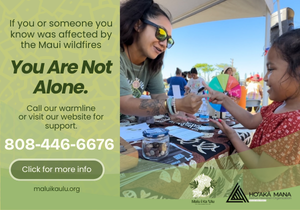Buying Local, Eating Healthy
Program offers fresh produce with easy to consume instructions.
By Jennifer Smith
Eating healthy on Molokai just became a bit easier, as Pu`u O Hoku Ranch now offers local produce boxes. The fruit and veggie sales are part of an ongoing Community Supported Agriculture (CSA) project at the Ranch.
“It’s a huge opportunity,” said Debbie Thiel, farm intern. She sees the farm and ranch work at Pu`u O Hoku as part of “a big picture of total sustainability” for the island. “It needs to happen.”
While the Ranch has grown vegetables for several years, and sold occasionally at the Saturday farmers’ market in town, the new CSA boxes offer residents the opportunity to buy produce weekly in bulk.
A Fertile Land
Pu`u O Hoku uses farming techniques from the biodynamics school of thought. “It goes beyond the concept of organic,” said Guido Frosini, farm intern. The chemical-free farming also takes into account forces of nature such as moon cycles, and rotates planting fields to ensure sustainability of the land.
“Molokai is very fertile, it can produce a tremendous amount of food,” Frosini said, adding that Pu`u O Hoku also offers organic beef. He said at nearly 14,000 acres, the area contains “a full spectrum of food,” which includes a farm, ranch, hunting, and fishing grounds.
However, one of the biggest cash crops for the ranch is also one that is not widely distributed on Molokai. The nearly 13 different varieties of awa plants grown at Pu`u O Hoku are in high demand with kawa bar owners on the surrounding islands.
Looking to the Future
According to Frosini, work is also currently underway to create a certified kitchen at Pu`u O Hoku. This would allow for the creation of value-added products on site, such as making poi out of taro.
Hoping to one day establish farm tours and demonstrations, he said, “We want to set up a place where anybody can come and learn, especially local people.”
For now, however, people can learn from the delicious recipes provided with purchased produce boxes. Farm intern and culinary school graduate Lamertia Gorsich said most people don’t eat a lot of vegetables because they don’t know how to cook them.
She said the recipes provided teach people “how to use produce” and “how to improve their health.” The eventual goal, she said, is that people will know “how to create a wonderful dish out of something they’ve grown.”
Veggies for Sale
Most of the produce at Pu`u O Hoku averages $3 a pound. A box containing a variety of vegetables is $25.
“The idea is to provide local produce at a price that people can afford,” Gorsich said, explaining that the prices are comparable if not lower than other organic vendors around the islands.
The CSA program could service between 25-30 families a week. As of last week, the program had 10 weekly customers.
For more information, or to order a CSA box call 558-8167.
The Founders
In acknowledging the exciting developments at Pu`u O Hoku’s farm, it is important to recognize all of those who came before, enabling the CSA program to exist.
A big mahalo to Jack Spruance and Jamie Ronzello who helped to set the foundation for future farmers Rachel, Brenda, Maggie, Megan, Vince, Julia, Noah, and Willa to create a healthy and thriving garden.
Also a big mahalo to the fence line crew: Chuck Miller, Shannon Kalipi, Jim Henderson, Anthony Welch, and George Coelho.










